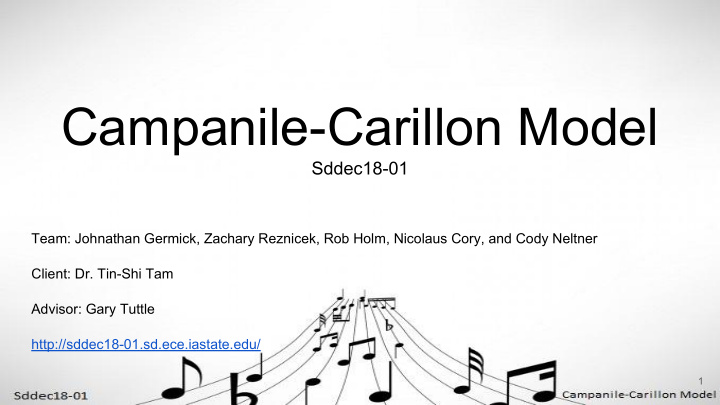



Campanile-Carillon Model Sddec18-01 Team: Johnathan Germick, Zachary Reznicek, Rob Holm, Nicolaus Cory, and Cody Neltner Client: Dr. Tin-Shi Tam Advisor: Gary Tuttle http://sddec18-01.sd.ece.iastate.edu/ 1
Overview ● Educate public ● Musical instrument ● Mobile Campanile-carillon model ● Campanile tutorial ● Use at school events 2
Our Team ● Passion for music ● Love the ISU campanile ● Necessary technical skills acquired through coursework ○ Basic Programming background ○ Circuit design/soldering experience ● Desire to learn new skills 3
Task Responsibility/Contributions ● John: Team Leader ● Nic: Application Engineer ● Rob: Quality Engineer ● Cody: Scribe ● Zach: Lead Software Engineer 4
Educating the public ● Display history ● Showcase Engineering student skills ● Experience the Bells of Iowa State ● Spread ISU pride 5
Carillon tutorial ● Anyone can play ● Inspire people to make/play music ● Falling notes ● Light up keys 6
7
Functional requirements ● Carillon Tutorial with song library ● Display electronic sheet music ● Allows layperson to play instrument ● Display Historical Information ● Weather Resistant 8
Non-functional requirements ● User friendly interface ● Non intrusive for carillonneurs ● Diagnostic manual for troubleshooting ● Classical appearance, minimally invasive 9
Constraints ● Must be weather resistant ● Must run off batteries and 120V power ● All solutions must fit on the model ● Must be prepared to implement design in November of 2018 10
Market Survey ● Others ○ “Standard-sized” carillons (more than 47 bells) ○ Few are mobile ○ None with a tutorial software 11
Market Survey Continued ● Other software: ○ Synthesia, Guitar Hero 12
Potential Risks ● Electrical connections/solder joints ● Circuit minimally intrusive to instrument ● Troubleshooting guide/operating manual ● Hardware/Software replacement 0.4 inches 13
Resource/Cost Estimate ● Hardware cost: $600 ● Monitors: $650 ● Battery solution: $1000 ● Total Cost: $2250* *Approximate cost 14
Major Milestones from this semester ● Display “Falling notes” ● Illuminate lights through software commands ● Integrated LEDs into baton Baton prototype 15
16
HW/SW used ● HW: ○ Raspberry Pi: Display and communicate to arduino ○ Arduino: Communication to LEDs ○ WS2812b LEDs: addressable LEDs need one data wire ● SW: ○ C++ ○ Python: serial port to Arduino ○ Arduino IDE ○ Solidworks 17
Test Plan ● Tested multiple LED strings ● LED durability test, vibration, brightness ● Software testing ● Waterproofing tests 18
Current status ● Began building prototype ● Developing code ○ RPI ○ Arduino 19
Schedule for Fall and Future Milestones ● Obtain custom keys from Rick Watson, carillon designer ● Bells are cast ● Model fully built ● Select monitors* ● Develop Power supply solution* ● Write diagnostic manual* ● Implement proposed design 20
Summary ● Create interface that enables anyone to play ○ RPI Falling Notes software ○ Display sheet music ○ Addressable LEDs from Arduino ● Integrate with current design ○ Develop prototype ● Display documentary 21
Recommend
More recommend